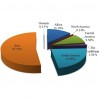Abstract
The market demand for tropical fruits has been growing steadily over the past two decades. Global papaya production has grown significantly over the last few years, mainly as a result of increased production in India. Papaya has become an important agricultural export for developing countries, where export revenues of the fruit provide a livelihood for thousands of people, especially in Asia and Latin America. Papaya exports contribute to the growing supply of healthy food products on international markets. The top three exporting countries accounted for 63.28 percent of the total global exports of papaya between 2007 and 2009, with more than half of those exports going to the United States. This 7-page fact sheet provides information on global trends in the production and trade of papaya. An overview of the current and future trends of global papaya production and trade, and the main papaya exporting and importing countries, is presented herewith. Written by Edward A. Evans and Fredy H. Ballen, and published by the UF Department of Food and Resource Economics, September 2012.
FE913/FE913: An Overview of Global Papaya Production, Trade, and Consumption (ufl.edu)
References
FAO. 2006. The Impact of Post-Harvest Handling Losses. http://www.fao.org/es/esc/common/ecg/227/en/
FAOSTAT. 2012a. Crop Production. http://faostat.fao.org/site/567/default.aspx#ancor
FAOSTAT. 2012b. Detailed Trade Data. http://faostat.fao.org/site/535/default.aspx#ancor
IBRAF (Brazilian Fruit Institute). 2012a. Brazilian Fruit Information for Consumers: Papaya. http://www.brazilianfruit.org/ingles/information_for_Consumer/consumer_papaya.asp?produto=7
IBRAF (Brazilian Fruit Institute). 2012b. Fresh Fruits Statistics. http://www.ibraf.org.br/estatisticas/est_frutas.asp (in Portuguese)
Mendoza, T., C. Laurena, and J. Botella. 2008. Recent advances in the development of transgenic papaya technology. Biotechnology Annual Review 14:423-462. https://doi.org/10.1016/S1387-2656(08)00019-7
SIAP (Mexican Agricultural Information Service). 2012. International Trade. http://www.siap.gob.mx/index.php?option=com_content&view=article&id=50&Itemid=380 (in Spanish)
SIB (Statistical Institute of Belize). 2012. Statistics: External Trade. http://www.statisticsbelize.org.bz/dms20uc/dm_browse.asp?pid=4
The Hindu Business Line. 2011. Papaya: Introducing high-yield varieties key to healthy profits. http://www.thehindubusinessline.com/industry-and-economy/agri-biz/article2726583.ece
UN Comtrade. 2012. http://comtrade.un.org/

